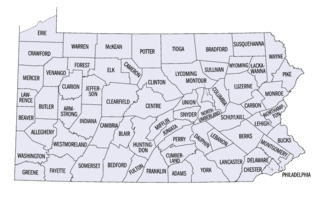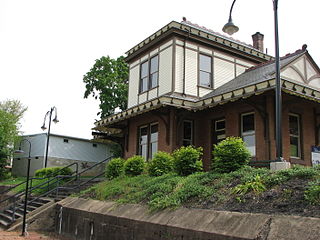
Stevenson is an unincorporated community located in the Green Spring Valley in Baltimore County, Maryland, United States. From 1830 until 1955, this community was served by the Green Spring Valley Branch of the old Northern Central Railway.

The Western Maryland Railway was an American Class I railroad (1852–1983) which operated in Maryland, West Virginia, and Pennsylvania. It was primarily a coal hauling and freight railroad, with a small passenger train operation.

The Northern Central Railway (NCRY) was a Class I Railroad connecting Baltimore, Maryland with Sunbury, Pennsylvania, along the Susquehanna River. Completed in 1858, the line came under the control of the Pennsylvania Railroad (PRR) in 1861, when the PRR acquired a controlling interest in the Northern Central's stock to compete with the rival Baltimore and Ohio Railroad (B&O). For eleven decades the Northern Central operated as a subsidiary of the PRR until much of its Maryland trackage was washed out by Hurricane Agnes in 1972, after which most of its operations ceased as the Penn Central declined to repair sections. It is now a fallen flag railway, having come under the control of the later Penn Central, Conrail, and then broken apart and disestablished. The northern part in Pennsylvania is now the York County Heritage Rail Trail which connects to a similar hike/bike trail in Northern Maryland down to Baltimore, named the Torrey C. Brown Rail Trail. Only the trackage around Baltimore remains in rail service.

This is a list of properties and districts listed on the National Register of Historic Places in Pennsylvania. As of 2015, there are over 3,000 listed sites in Pennsylvania. Sixty-six of the 67 counties in Pennsylvania have listings on the National Register; Cameron County is the only county without any sites listed.

The Raystown Branch Juniata River is the largest and longest tributary of the Juniata River in south-central Pennsylvania in the United States.

Begun in 1898 in rural Frederick County, Maryland, the LeGore Bridge was completed and opened to the public in 1900. It was built and maintained by the owners of the LeGore Lime Company, including local businessman James William LeGore and his company advisor, Eugene Hammond. It is 340 feet (105m) in length, 27 feet (8.3m) wide and 64 feet (16.7m) high. The bridge is situated at 39°35'N 77°19'W. The five arch limestone bridge was restored in 1981 and 2009.
Codorus Creek is a 42.4-mile-long (68.2 km) tributary of the Susquehanna River in York County, Pennsylvania in the United States.

The King Iron Bridge & Manufacturing Company was a late-19th-century bridge building company located in Cleveland, Ohio. It was founded by Zenas King (1818–1892) in 1858 and subsequently managed by his sons, James A. King and Harry W. King and then his grandson, Norman C. King, until the mid-1920s. Many of the bridges built by the company were used during America's expansion west in the late 19th century and early 20th century, and some of these bridges are still standing today.

The Central Railroad of New Jersey Freight Station in Scranton, Pennsylvania, United States, was the western terminus of the Central Railroad of New Jersey line, 192 miles (309 km) from its base of operations in Jersey City, New Jersey. It is located on West Lackawanna Avenue, over the Lackawanna River from downtown Scranton, near Steamtown National Historic Site. It is to be distinguished from the other legacy Scranton station, Delaware, Lackawanna & Western Scranton Station, where service persisted to January 6, 1970. Yet additional passenger train stations in Scranton were those of the Delaware and Hudson Railway and the Erie Railroad.

The Howard Tunnel is located near Seven Valleys, Pennsylvania. In operation since 1838, it is the second oldest active rail tunnel in the U.S. Originally constructed by the York and Maryland Line Rail Road, it formed a critical link in the north-south line assembled by the Northern Central Railway.

New Freedom is a historic railway station located at New Freedom, York County, Pennsylvania. It was built about 1870 by the Northern Central Railway, and is a 1 1/2-story, rectangular frame building with a gable roof and overhanging eaves. The building ceased to be used as a railway station in 1960.

Millersburg is a historic railway station located at Millersburg, Dauphin County, Pennsylvania. It was built in 1898, by the Northern Central Railway. It is a two-story, brick and frame building in the Queen Anne style. It features a deep porch around three sides. The property also includes the stone foundation of the original baggage house. It was used as a passenger station until 1960. In 1982, it was acquired by the Historical Society of Millersburg. It is used as an information center for tourists and visitors and houses offices of the Millersburg Ferry Boat Association and Millersburg Area Chamber of Commerce.

Valley Road Bridge, Stewartstown Railroad is a historic railroad bridge in Hopewell Township, York County, Pennsylvania. Built for the Northern Central Railroad in 1870, the 190 foot long bridge was disassembled and reassembled on the Stewartstown Railroad in 1885. A girder structure was added in 1920, and the original bridge structure was removed, although the original 1870 trusses are still in place. The bridge is still in active use, and services the Stewartstown Railroad passenger excursions.

Bridge 182+42, Northern Central Railway is a historic stone arch railroad bridge in Shrewsbury Township, York County, Pennsylvania. It was built in 1871, and measures about 80-foot-long (24 m) overall. The limestone and granite bridge was built by the Northern Central Railway and crosses Codorus Creek.

Bridge 634, Northern Central Railway is a historic stone arch railroad bridge in Shrewsbury Township, York County, Pennsylvania. It was built in 1871, and measures about 80-foot-long (24 m) overall. The brown limestone and brick bridge was built by the Northern Central Railway and crosses a roadway and Codorus Creek.

Bridge 5+92, Northern Central Railway is a historic railroad bridge in Seven Valleys, York County, Pennsylvania. It was built in 1900, and measures about 30-foot-long (9.1 m) overall. The girder bridge on granite abutments was built by the Northern Central Railway and crosses a roadway.
Glen Rock Historic District is a national historic district located at Glen Rock in York County, Pennsylvania. The district includes 287 contributing buildings, 1 contributing site, and 4 contributing structures in the central business district and surrounding residential area of Glen Rock. The houses are mostly 2+1⁄2-story, vernacular wood-frame buildings, built between 1838 and 1945, with some notable Queen Anne and Bungalow/craftsman style dwellings. Notable buildings include the Philip Shaffer House, the "Castle" (1889), Peoples Bank of Glen Rock (1912), Glen Theatre (1913), Glen Rock Hose and Ladder Company (1904), Zion Evangelical Lutheran Church (1905), Immanuel United Methodist Church (1926), Industrial Sewing Company (1916), Glen Traditionals building (1921), and Accufab building. A contributing structure is the Northern Central Railway bridge.

The Chicago and North Western Railroad Bridge is a bridge on the National Register of Historic Places in Pierre, South Dakota. It was the first permanent bridge across the Missouri River in central South Dakota. The Pennsylvania through truss bridge is 2,200 feet (670 m) long and has two spans. The bridge's second span is a swing span; the bridge is the only extant swing bridge in South Dakota. The Chicago and North Western Railway built the bridge in 1907. It was added to the National Register on November 19, 1998. It currently is part of the PRC Subdivision railway line owned and operated by the Rapid City, Pierre and Eastern Railroad.

Knecht's Covered Bridge is a historic covered bridge in Springfield Township, Bucks County, Pennsylvania. It crosses Cooks Creek on Knecht Bridge Road south of Springtown. Built in 1873 in the town truss style, the bridge is 110 feet long and 15 feet wide.

Chesterton is a disused train station in Chesterton, Indiana. The current depot replaced a wooden structure built in 1852 for the Northern Indiana and Chicago Railroad, a predecessor road of the Lake Shore and Michigan Southern Railway, that burned down in 1913. It was rebuilt in 1914 as a brick structure. By 1914, Cornelius Vanderbilt of the New York Central and Hudson River Railroad held a majority interest in the Lake Shore and Michigan Southern Railway. The Southern Railways trackage provided an ideal extension of the New York Central from Buffalo to Chicago. On December 22, 1914, the New York Central and Hudson River Railroad merged with the Lake Shore and Michigan Southern Railway to form a new New York Central Railroad.






















